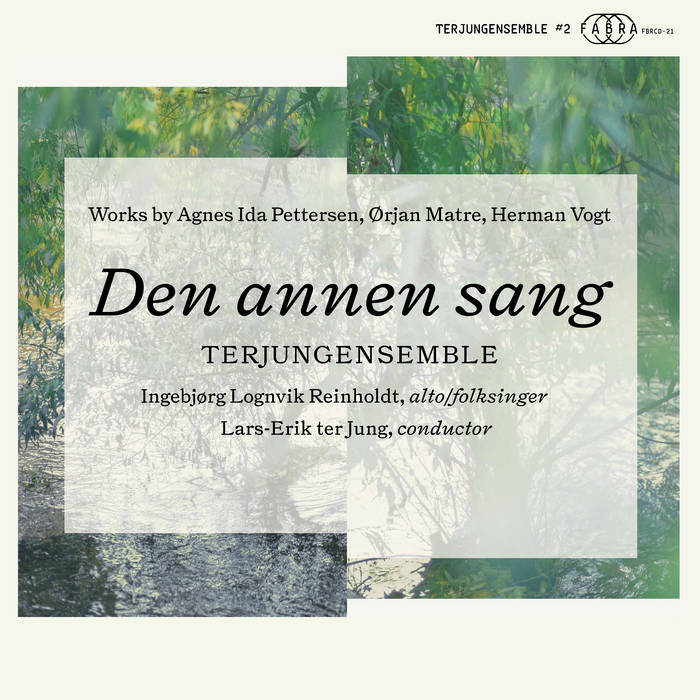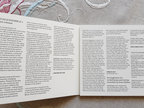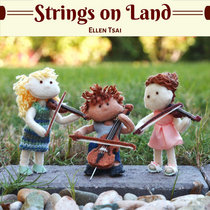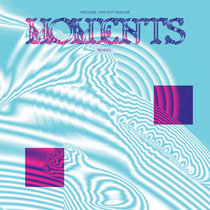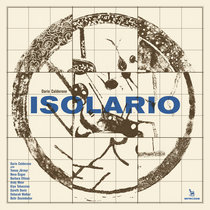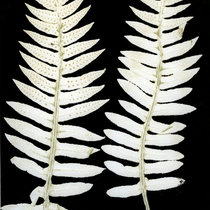
Herman Vogt: «Den annen sang»
from Den annen sang (binaural edition) (FBRCD-21) by TERJUNGENSEMBLE, Ingebjørg Lognvik Reinholdt
-
Streaming + DownloadIncludes unlimited streaming via the free Bandcamp app, plus high-quality download in MP3, FLAC and more.
7 NOK or more
-
Buy the Full Digital Album
-
Compact Disc (CD) + Digital AlbumIncludes unlimited streaming of Den annen sang (binaural edition) (FBRCD-21) via the free Bandcamp app, plus high-quality download in MP3, FLAC and more.ships out within 2 days
75 NOK or more
about
About Den annen sang
Den annen sang (“The Second Song”) is a musical arrangement of the psalm Herre Gud, ditt dyre navn og ære (“Lord God, Thy dear Name and Honour”), the most famous poem by the Norwegian priest and poet Petter Dass (1647-1707). The first version of the psalm was completed in 1698, but it was first published in Dass’ Catechism Songs in 1715. It is based on the second line of the Lord’s Prayer, which is why it is presented under the heading “The Second Song. Hallowed be thy Name”. It is considered one of the masterpieces of Norwegian psalm-writing, and it is the Norwegian psalm associated with most different melodies: over 50 are recorded, with the most commonly used ones coming from Romedal, Rana and Ørsta. Those are the three melodies that have been used here.
Gustav Jensen’s 1909 version of the song was published in Landstad’s revised book of psalms in 1926. That adaptation, which greatly abridges the original to just three verses, is the one that is well-known in Norway today. My work, however, is based on Dass’ original version, and includes all sixteen verses. The original is far more powerful than Jensen’s reworking, both as a whole and in its many wonderful rhymes. “‘The song is often praised for its rich sonority”, writes professor of literature Jon Haarberg in the Great Norwegian Encyclopaedia. The poem is in many ways an expression of its time. It talks about the day of judgement and Lutheran virtue ethics, which probably feel rather remote, and even irrelevant, to most people today. In spite of that, the poem’s cultural importance in Norway, as well as its linguistic musicality and the many powerful poetic images, meant that I wanted to grapple with the text. Moreover, the poem speaks of how people relate to nature and the elements, and particularly of their relationship with all life at sea. This reflects the culture of Northern Norway, where fishing was such a key part of people’s lives. In addition, it is as if almost the whole of creation and all life forms are presented in an existential symbiosis – which is rather modern, given the importance our current age places on nature conservation and ecology.
The composition takes the form of a theme and variations. All of the verses are presented chronologically, separated by interludes played by the ensemble. The two folk melodies from Rana and Ørsta alternate throughout the work, until in the final two verses the music “lands” on the melody from Romedal, which is perhaps the best-known one.
In a detailed textual analysis of the psalm, Haarberg stresses that both the first and last verses (1 and 16) contain invocations of God. Between them, the song can be divided into two main sections: verses 2-10, and verses 11-15. “The first main section is not an exhortation, but rather a statement that all of creation wants to praise its Lord for his omnipotence, which is universal: Gud er Gud om alle Mand var døde (5.1 ‘God would still be God, were all Men dead’). The second main section addresses itself to humankind (“O People”; 11.1), to a ‘you’. Here each individual believer is exhorted to praise God, not just in words, but in deeds, in order to promote God’s kingdom. Verse 10 acts as a kind of bridge between the two main sections. It introduces an ‘I’ figure who contemplates their imperfect body. This ‘I’ is of course part of creation, and as such belongs in part 1, but by committing to living a Godfearing life, it also points forward to part 2.”
In this arrangement, verses 9, 10 and 11 are different from the rest. An almost frozen calm, where the ensemble produces shimmering sounds, represents the axis of the piece, and contrasts with the otherwise warm tones of the string instruments. The musical transition coincides with verse 9: Vil de Gamle være stiv og sove, Da skal Børn i Moders Liv GUD love; De Halte, Lamme, Maal-løse, Stamme Giør og det samme, de Gromme, Gramme Og Grove. (“If the Old are stubborn and heedless, Children in their Mothers’ Wombs shall praise GOD; The Halt, Lame, Mute and Stammerers Do the same, the Bad, Bitter and Base.”) Verse 14, with its virtue ethics, provides a kind of musical climax to the work, symbolising our Protestant cultural sphere, for better and worse: Had alt det GUD i sit Ord selv hader, At Vellysten dig paa Jord ey skader, Sky Synd og Lyder, som GUD forbyder, Elsk Tugt og Dyder, som dig bepryder Og bader. (“Hate what the Word says GOD does hate, So earthly Pleasures do not defile thee, Shun Sins and Vices, that GOD forbids, Love Modesty and Virtue, that grace and enrich thee.”)
In the final two verses, the work reaches an equilibrium. Humankind puts its fate into God’s hands, praying for God to prevent evil and help us to avoid the “Path of the Sinner”: Men ô GUD! forhindre sligt at blive! Hvad som er u-gudeligt fordrive! At vi vor Tider mod Synden strider, Naar Tiden lider, hos dig omsider At blive! (“But, LORD, let it not come to pass! Cast out all that is ungodly! So we on Earth, against Sin strive, And when that Day comes, may stay by Thy side!”) The end may represent a longing for existential unity and eternal rest. The work has an instrumental coda that gradually descends in pitch until it ends in a deep unison.
Herman Vogt
Den annen sang (“The Second Song”) is a musical arrangement of the psalm Herre Gud, ditt dyre navn og ære (“Lord God, Thy dear Name and Honour”), the most famous poem by the Norwegian priest and poet Petter Dass (1647-1707). The first version of the psalm was completed in 1698, but it was first published in Dass’ Catechism Songs in 1715. It is based on the second line of the Lord’s Prayer, which is why it is presented under the heading “The Second Song. Hallowed be thy Name”. It is considered one of the masterpieces of Norwegian psalm-writing, and it is the Norwegian psalm associated with most different melodies: over 50 are recorded, with the most commonly used ones coming from Romedal, Rana and Ørsta. Those are the three melodies that have been used here.
Gustav Jensen’s 1909 version of the song was published in Landstad’s revised book of psalms in 1926. That adaptation, which greatly abridges the original to just three verses, is the one that is well-known in Norway today. My work, however, is based on Dass’ original version, and includes all sixteen verses. The original is far more powerful than Jensen’s reworking, both as a whole and in its many wonderful rhymes. “‘The song is often praised for its rich sonority”, writes professor of literature Jon Haarberg in the Great Norwegian Encyclopaedia. The poem is in many ways an expression of its time. It talks about the day of judgement and Lutheran virtue ethics, which probably feel rather remote, and even irrelevant, to most people today. In spite of that, the poem’s cultural importance in Norway, as well as its linguistic musicality and the many powerful poetic images, meant that I wanted to grapple with the text. Moreover, the poem speaks of how people relate to nature and the elements, and particularly of their relationship with all life at sea. This reflects the culture of Northern Norway, where fishing was such a key part of people’s lives. In addition, it is as if almost the whole of creation and all life forms are presented in an existential symbiosis – which is rather modern, given the importance our current age places on nature conservation and ecology.
The composition takes the form of a theme and variations. All of the verses are presented chronologically, separated by interludes played by the ensemble. The two folk melodies from Rana and Ørsta alternate throughout the work, until in the final two verses the music “lands” on the melody from Romedal, which is perhaps the best-known one.
In a detailed textual analysis of the psalm, Haarberg stresses that both the first and last verses (1 and 16) contain invocations of God. Between them, the song can be divided into two main sections: verses 2-10, and verses 11-15. “The first main section is not an exhortation, but rather a statement that all of creation wants to praise its Lord for his omnipotence, which is universal: Gud er Gud om alle Mand var døde (5.1 ‘God would still be God, were all Men dead’). The second main section addresses itself to humankind (“O People”; 11.1), to a ‘you’. Here each individual believer is exhorted to praise God, not just in words, but in deeds, in order to promote God’s kingdom. Verse 10 acts as a kind of bridge between the two main sections. It introduces an ‘I’ figure who contemplates their imperfect body. This ‘I’ is of course part of creation, and as such belongs in part 1, but by committing to living a Godfearing life, it also points forward to part 2.”
In this arrangement, verses 9, 10 and 11 are different from the rest. An almost frozen calm, where the ensemble produces shimmering sounds, represents the axis of the piece, and contrasts with the otherwise warm tones of the string instruments. The musical transition coincides with verse 9: Vil de Gamle være stiv og sove, Da skal Børn i Moders Liv GUD love; De Halte, Lamme, Maal-løse, Stamme Giør og det samme, de Gromme, Gramme Og Grove. (“If the Old are stubborn and heedless, Children in their Mothers’ Wombs shall praise GOD; The Halt, Lame, Mute and Stammerers Do the same, the Bad, Bitter and Base.”) Verse 14, with its virtue ethics, provides a kind of musical climax to the work, symbolising our Protestant cultural sphere, for better and worse: Had alt det GUD i sit Ord selv hader, At Vellysten dig paa Jord ey skader, Sky Synd og Lyder, som GUD forbyder, Elsk Tugt og Dyder, som dig bepryder Og bader. (“Hate what the Word says GOD does hate, So earthly Pleasures do not defile thee, Shun Sins and Vices, that GOD forbids, Love Modesty and Virtue, that grace and enrich thee.”)
In the final two verses, the work reaches an equilibrium. Humankind puts its fate into God’s hands, praying for God to prevent evil and help us to avoid the “Path of the Sinner”: Men ô GUD! forhindre sligt at blive! Hvad som er u-gudeligt fordrive! At vi vor Tider mod Synden strider, Naar Tiden lider, hos dig omsider At blive! (“But, LORD, let it not come to pass! Cast out all that is ungodly! So we on Earth, against Sin strive, And when that Day comes, may stay by Thy side!”) The end may represent a longing for existential unity and eternal rest. The work has an instrumental coda that gradually descends in pitch until it ends in a deep unison.
Herman Vogt
credits
from Den annen sang (binaural edition) (FBRCD-21),
released January 27, 2021
license
all rights reserved
tags
about
Fabra Oslo, Norway
Fabra label of Norway was founded in 1993 and has presently released 29 albums and 4 ep's. Run by Geir Inge Lotsberg. All artwork by Erik Johan Worsøe Eriksen.
contact / help
If you like Fabra, you may also like:
